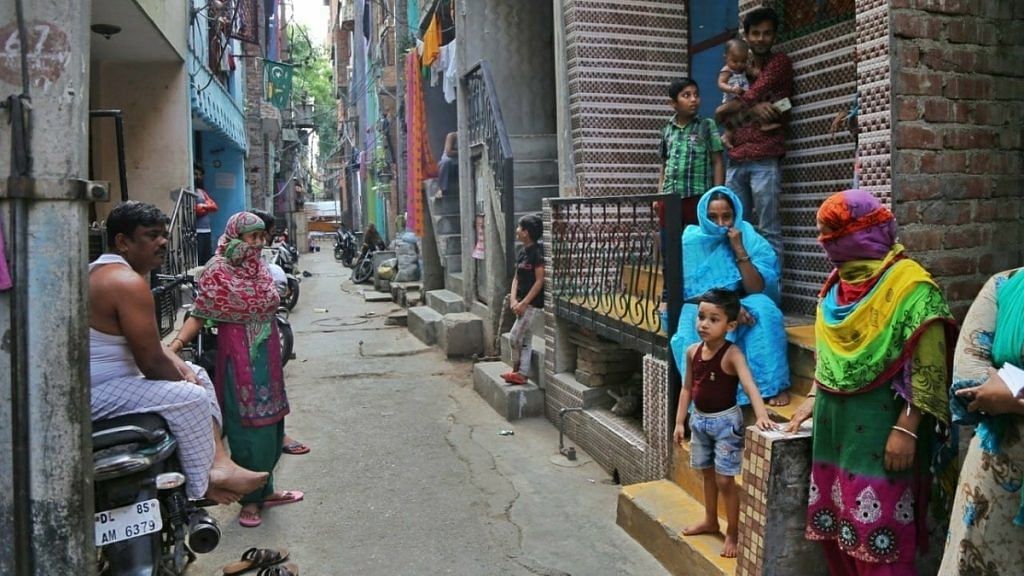New Delhi: In the ‘C’ Block of Jahangirpuri in the national capital, a 55-year-old woman tested positive for Covid-19 on 9 April. This result came four days after her death. By then, at least 26 of Ajiman Bibi’s relatives who live in the same neighbourhood, and five more reported persons had caught the infection.
ThePrint spoke to her neighbours in the area, which has now been declared a containment zone, and most of them said that no one had a clue that Bibi had Covid-19.
“No one knew she had coronavirus, it was only learnt after she died and the test results came in. If people knew, they wouldn’t have interacted with her,” her family’s neighbour Sheikh Habibullah told ThePrint. “She had countless health issues — diabetes, tuberculosis, thyroid problems, and obesity. I have grown up watching her ill.”
Bibi breathed her last at the Ram Manohar Lohia (RML) hospital on 5 April — before which she spent days hopping from one hospital to another for treatment.
“She started experiencing extreme breathlessness late March so her family took her to Jagjivan Ram hospital. After that, she went to Baba Saheb Ambedkar Hospital. Then she went to a TB camp of some other hospital to get herself checked, and finally she was taken to RML,” Habibullah said.
Her relatives and neighbours suspect that it was during one of these hospital visits that she contracted the infection.
“The family doesn’t have the money or status to even roam around Delhi properly, so there is no chance that they interacted with someone who flew in from outside,” said Sirajul Khan, another neighbour of her family. “She was already a heart and lung patient, which made matters worse.”
Bibi lived in her home with 14 other family members: her husband, five sons, three daughter in-laws and five grand-children.
After she passed away, relatives visited the family to extend condolences. Some also went to her burial in a nearby graveyard.
“We didn’t go because of the lockdown, but close friends and family will of course go. Back then, no one had any idea that she had coronavirus, so it’s natural for people to go,” said Salma Khatoon, one of the in-laws of the family, who also lives in the same area.
Speaking to ThePrint, north Delhi district magistrate Deepak Shinde told ThePrint that all 31 infected people have been sent to a quarantine facility in Narela. “There are many children in the group too,” said Shinde.
Also read: Indian firms begin developing remdesivir for Covid-19 research, hope to land licensing deal
The containment zone
Now, the ‘C’ Block in Jahangirpuri has been declared as one of the 87 containment zones in the national capital. Congested roads amid small houses, shanties and shops with lanes seamlessly merging into each other mark this block.
While entry into the lane of the deceased’s house has been cut off, the homes in the neighbourhood haven’t been put under isolation yet.
The spread of the infection to 31 people of the area prompted Delhi Chief Minister Arvind Kejriwal to appeal to people to follow the lockdown restrictions strictly. “They had been visiting each other even when the area was declared a containment zone,” Kejriwal said in a press briefing last week.
However, while Block ‘B’ of Jahangirpuri was one of the first 22 containment zones in Delhi announced on 8 April, Block ‘C’ was also added to the list later.
After the incident hit the headlines, all the lanes of Jahangirpuri C-block opening into the main road have been sealed – a move that has left many in the region unhappy.
Also read: Mumbai’s high Covid count due to aggressive testing but 81% cases asymptomatic: BMC chief
‘Very difficult’
The residents of the lanes peeking out of barricades said their “life has become unbearable” ever since the area was cordoned off.
“We can’t go out to buy ration, we can’t go out to get water. No one comes inside for sanitation either. It’s become very difficult,” said Divyanshu Kumar, a resident of a lane adjacent to the one where the woman’s family lives.
“It’s good they cordoned off the area as a precaution. But corona (Covid-19) isn’t our only worry, feeding ourselves is also important,” said Zeenat Alam, another resident.
In Block ‘G’ of Jahangirpuri, which is another containment zone just a couple of hundred meters away from the woman’s family home, officials from the district administration have been announcing the importance of staying indoors.
Sanjay Kumar, an official assigned duty in the area, said it is a struggle for him to get people to stay indoors here.
“Homes here are also very small, so people tend to step out for fresh air. Plus, food and milk are also important needs. But we try our best to make sure people at least maintain social distancing while stepping out,” he said.
Also read: India’s Covid-19 R0 down to 1.36 now, 25,000 cases by April-end at this rate: IMS scientist
